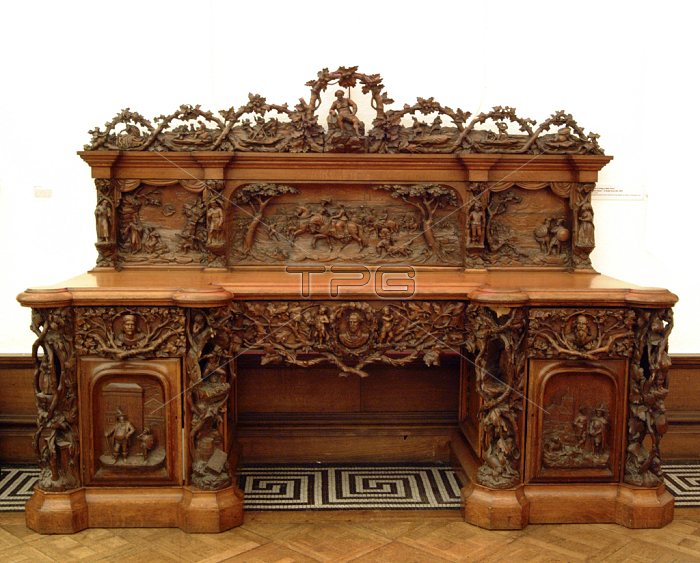
3833257 The Shakespeare Sideboard, 1862-63 (wood) by Robinson, Gerrard (1834-91); 167x292x95 cm; Shipley Art Gallery, Gateshead, Tyne & Wear, UK; (add.info.: On his death in 1891, Gerrard Robinson was described by the Newcastle Daily Chronicle as having been "foremost amongst the woodcarvers of the kingdom". His reputation was gained in the 1860s through the production of a small number of massive sideboards each minutely carved with literary or historical scenes. The \'Chevy Chase\' sideboard, completed in 1863, was always recognised as Robinson\'s masterpiece. It is made up of six panels carved in high relief, telling a story like a book or series of three-dimensional paintings. This narrative element in his work, together with the enormous skill and effort expended in the carving, was greatly appreciated by Robinson\'s patrons, although good commissions became increasingly scarce from the later 1870s as carved furniture rapidly fell from fashion. On the \'Chevy Chase\' sideboard, six carved tableaux depicted scenes from the Border ballad of Chevy Chase, a romanticised version of the battle between Harry Hotspur and his men on the English side, and Earl Douglas and his Scottish knights, which took place in 1388. \'Nothing equal to it for the highly ornate and artistic character of its carvings has ever been seen in England\' enthused one reviewer in 1863, \'and we very much question whether its embellishments have ever been surpassed for boldness and unity of conception and elaboration of detail.\' The sideboard was exhibited at Newcastle\'s Central Exchange in August 1863, but was not sold. Towards the end of 1863, Robinson left Newcastle for London, taking the Chevy Chase sideboard with him. Robinson remained in London for three years, giving lessons in wood-carving to a number of enthusiasts, including Miss Ellis and the Earl of Caithness. Most of his carving during this period was of statuettes, panels and brackets rather than larger items of carved fumiture, which were already becoming rather unfashionable. Robinson returned to Newcastle in 1866 One of Robinson\'s most important commissions during the late 1860s was the carving of an immense library chimney-piece for Lord Manvers\'new mansion, Thoresby, Nottinghamshire, showing Robin Hood and Little John [fig.7J. On seeing the piece in Robinson\'s workshop before delivery to Thoresby, a local paper wrote, \'Mr Robinson is a man of real genius. If his reputation were not already made, the carving of the Major Oak would make it\'. The chimney-piece acted as a splendid advertisement, gaining Robinson a number of commissions, including in 1871 a sideboard for Sir George Chetwynd of Grendon Hall, Staffordshire inspired by Frith\'s painting \'Derby Day\'. Robinson\'s work at that time mainly took the form of large figurative panels, including a fine \'Otter Hunt\' panel after Landseer and an elaborate boar hunt. However, the declining popularity of such pieces combined with Robinson??? diffident personality led to a decline in his fortunes, and he died poor. Based on text by Rosamund Allwood.); Tyne & Wear Archives & Museums.
| px | px | dpi | = | cm | x | cm | = | MB |
Details
Creative#:
TOP27624202
Source:
達志影像
Authorization Type:
RM
Release Information:
須由TPG 完整授權
Model Release:
No
Property Release:
No
Right to Privacy:
No
Same folder images:

 Loading
Loading